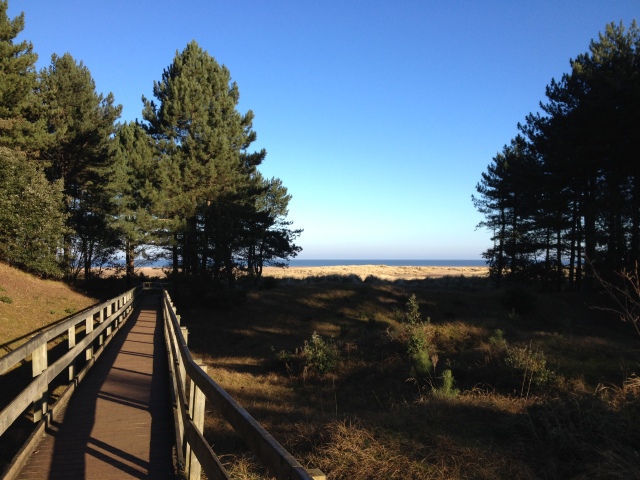Tom and I have just spent two nights and two days in Norfolk. We missed loads of birds – some because we couldn’t get there in time (Ferruginous Duck), others because they weren’t where they were supposed to be when we did get there (Snow Bunting, Water Pipit). But this is Norfolk – and even if you miss a few birds, you still end up having a fantastic time and seeing a large number of different species – we beat our day record with 74 species on the first day!
This trip turned out to be special in another way too – we found our first “rarity” without outside help. OK – most birders aren’t going to get too excited by this one, but we believe the bird below is an Icelandic Redwing – a subspecies of Redwing that isn’t often reported on the East coast as far as we can tell. It has much darker markings on its breast, and the paler areas of the head are yellow rather than white. It landed within 5 yards of us and wasn’t at all bothered by us staring at it. I’m glad I bought the Challenge Series: Winter book a few months ago, as before then I’d never heard of this subspecies. Even if it isn’t accepted as an Icelandic, we certainly enjoyed the excitement of finding it.

But I’m telling the story of the weekend in the wrong order. We stayed at Briarfields Hotel which is almost next door to Titchwell, so we were on the reserve very quickly after breakfast. We tried to hurry along the path to the beach as Long-tailed Ducks had been reported offshore all week, but we kept getting delayed by other birds – Bramblings on the feeders and Bar-tailed Godwits feeding in the mud to name but two. In the end, we only got brief glimpses of two male Long-tailed Ducks as the flock had moved a little further west that day, but the Velvet Scoters and a huge raft of Common Scoter made up for it. On the way back to the Visitors Centre for lunch we were again held up by more birds, including a Peregrine buzzing the waders.
Titchwell can take up most of your day if you aren’t careful, but we were glad we made it Holme in the afternoon, otherwise we’d have missed the Redwing. We got back to the hotel quite worn out, but on a high after such a good day – Tom was especially pleased to have had a Robin feed out of his hand and to make the acquaintance of “Mr Seagull” who followed us up and down Titchwell beach.

On the Sunday, we drove east along the coast to Holkham. In took us a while to get out of the car park – there were huge numbers of geese, ducks and snipe feeding in the fields either side, some just a few yards from the cars.
The bird that took the most effort to see was undoubtedly the Shore Lark. Rather than being at the end of the boardwalk at Holkham Gap, the flock had decided to move around a mile further west – quite a hike over sand whilst carrying two scopes. It was worth it when we got there though – 31 of them around a couple of pools on the sand about 20 yards away. Tom’s reaction when getting the telescope on them for the first time sums them up: “Wow – look at their faces! They are my new favourite British bird!”. We’ve never seen so many together and even though they came quite close, I only managed a poor record shot. In fact, it was so poor, I’ve decided to replace it with a shot of the boardwalk at Holkham. Tom has renamed all the trees in this area as “Norfolk Pines” – an appropriate name for them I think.

As you can see, the weather was stunning for January – so when we got to Cley we actually ate our lunch outside, before hurrying off to see if we could find the Siberian Chiffchaff that had been haunting the reeds beside the East Bank. Just think about why it is called that for a moment. I’ve never been to Siberia – maybe it is actually quite a pleasant place in summer – but I still struggle to understand how such a tiny bird could survive there and then have enough energy to fly all the way here!
We had to wait nearly an hour (although we were entertained by a Glaucous Gull, Marsh Harriers and a Smew whilst waiting), but it did eventually turn up. These are subtly different from our Common Chiffchaff being quite a bit greyer. However I’d never have been able to work this one out on my own – so the ID of the bird below is completely reliant on others!

We then had to regretfully head home, even though more exciting birds kept arriving on my phone. As we passed the “Welcome to Suffolk” sign on the way home, Tom said he wanted to live in Norfolk. I tried to cheer him up by saying that most birders would be very happy to live in Suffolk, if only because getting to Norfolk was so easy!
Local Patch versus Nature Reserves
At the end of last year I decided that I really ought to spend more time birding on my local patch rather than on nature reserves that I need to drive to. So how have we done in January?
Local patch: 3 visits
Nature reserves: Abberton Reservoir, Knettishall Heath, Lynford Arboretum, Titchwell, Holme, Holkham, Cley, Old Hall Marshes (with Dave), Alton Water, Sutton Heath, Bawdsey East Lane and North Warren
Total bird species seen: 127 (last year (our best year to date) we got to this number on 20th March).
Seems we just couldn’t resist!
